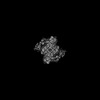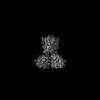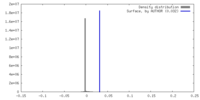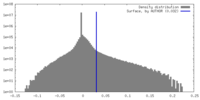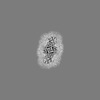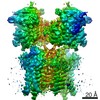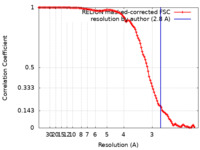登録情報 データベース : EMDB / ID : EMD-15717タイトル Resting state GluA1/A2 AMPA receptor in complex with TARP gamma 8 and ligand LY3130481 複合体 : GluA1/A2 AMPA receptor in complex with TARP gamma 8 and ligand LY3130481タンパク質・ペプチド : Isoform Flip of Glutamate receptor 2タンパク質・ペプチド : Voltage-dependent calcium channel gamma-8 subunitタンパク質・ペプチド : Isoform Flip of Glutamate receptor 1リガンド : {[7-morpholin-4-yl-2,3-dioxo-6-(trifluoromethyl)-3,4-dihydroquinoxalin-1(2H)-yl]methyl}phosphonic acidリガンド : (2R)-2,3-dihydroxypropyl (9Z)-octadec-9-enoateリガンド : PALMITIC ACIDリガンド : (2S)-3-(hexadecanoyloxy)-2-[(9Z)-octadec-9-enoyloxy]propyl 2-(trimethylammonio)ethyl phosphateリガンド : 6-[(1~{S})-1-[1-[5-(2-hydroxyethyloxy)pyridin-2-yl]pyrazol-3-yl]ethyl]-3~{H}-1,3-benzothiazol-2-one / / / 機能・相同性 分子機能 ドメイン・相同性 構成要素
/ / / / / / / / / / / / / / / / / / / / / / / / / / / / / / / / / / / / / / / / / / / / / / / / / / / / / / / / / / / / / / / / / / / / / / / / / / / / / / / / / / / / / / / / / / / / / / / / / / / / / / / / / / / / / / / / / / / / / / / / / / / / / / / / / / / / / / 生物種 Rattus norvegicus (ドブネズミ)手法 / / 解像度 : 2.8 Å Zhang D / Lape R / Shaikh S / Kohegyi B / Watson JF / Cais O / Nakagawa T / Greger IH 資金援助 Organization Grant number 国 Medical Research Council (MRC, United Kingdom) MRU105174197 Wellcome Trust 223194/Z/21/Z National Institutes of Health/National Institute of Mental Health (NIH/NIMH) R56/R01MH123474
ジャーナル : Nat Commun / 年 : 2023タイトル : Modulatory mechanisms of TARP γ8-selective AMPA receptor therapeutics.著者 : Danyang Zhang / Remigijus Lape / Saher A Shaikh / Bianka K Kohegyi / Jake F Watson / Ondrej Cais / Terunaga Nakagawa / Ingo H Greger / 要旨 : AMPA glutamate receptors (AMPARs) mediate excitatory neurotransmission throughout the brain. Their signalling is uniquely diversified by brain region-specific auxiliary subunits, providing an ... AMPA glutamate receptors (AMPARs) mediate excitatory neurotransmission throughout the brain. Their signalling is uniquely diversified by brain region-specific auxiliary subunits, providing an opportunity for the development of selective therapeutics. AMPARs associated with TARP γ8 are enriched in the hippocampus, and are targets of emerging anti-epileptic drugs. To understand their therapeutic activity, we determined cryo-EM structures of the GluA1/2-γ8 receptor associated with three potent, chemically diverse ligands. We find that despite sharing a lipid-exposed and water-accessible binding pocket, drug action is differentially affected by binding-site mutants. Together with patch-clamp recordings and MD simulations we also demonstrate that ligand-triggered reorganisation of the AMPAR-TARP interface contributes to modulation. Unexpectedly, one ligand (JNJ-61432059) acts bifunctionally, negatively affecting GluA1 but exerting positive modulatory action on GluA2-containing AMPARs, in a TARP stoichiometry-dependent manner. These results further illuminate the action of TARPs, demonstrate the sensitive balance between positive and negative modulatory action, and provide a mechanistic platform for development of both positive and negative selective AMPAR modulators. 履歴 登録 2022年9月2日 - ヘッダ(付随情報) 公開 2023年4月19日 - マップ公開 2023年4月19日 - 更新 2024年11月6日 - 現状 2024年11月6日 処理サイト : PDBe / 状態 : 公開
すべて表示 表示を減らす
 データを開く
データを開く 基本情報
基本情報
 マップデータ
マップデータ 試料
試料 キーワード
キーワード 機能・相同性情報
機能・相同性情報
 データ登録者
データ登録者 英国,
英国,  米国, 3件
米国, 3件  引用
引用 ジャーナル: Nat Commun / 年: 2023
ジャーナル: Nat Commun / 年: 2023


 構造の表示
構造の表示 ダウンロードとリンク
ダウンロードとリンク emd_15717.map.gz
emd_15717.map.gz EMDBマップデータ形式
EMDBマップデータ形式 emd-15717-v30.xml
emd-15717-v30.xml emd-15717.xml
emd-15717.xml EMDBヘッダ
EMDBヘッダ emd_15717_fsc.xml
emd_15717_fsc.xml FSCデータファイル
FSCデータファイル emd_15717.png
emd_15717.png emd-15717.cif.gz
emd-15717.cif.gz emd_15717_additional_1.map.gz
emd_15717_additional_1.map.gz emd_15717_half_map_1.map.gz
emd_15717_half_map_1.map.gz emd_15717_half_map_2.map.gz
emd_15717_half_map_2.map.gz http://ftp.pdbj.org/pub/emdb/structures/EMD-15717
http://ftp.pdbj.org/pub/emdb/structures/EMD-15717 ftp://ftp.pdbj.org/pub/emdb/structures/EMD-15717
ftp://ftp.pdbj.org/pub/emdb/structures/EMD-15717 emd_15717_validation.pdf.gz
emd_15717_validation.pdf.gz EMDB検証レポート
EMDB検証レポート emd_15717_full_validation.pdf.gz
emd_15717_full_validation.pdf.gz emd_15717_validation.xml.gz
emd_15717_validation.xml.gz emd_15717_validation.cif.gz
emd_15717_validation.cif.gz https://ftp.pdbj.org/pub/emdb/validation_reports/EMD-15717
https://ftp.pdbj.org/pub/emdb/validation_reports/EMD-15717 ftp://ftp.pdbj.org/pub/emdb/validation_reports/EMD-15717
ftp://ftp.pdbj.org/pub/emdb/validation_reports/EMD-15717 リンク
リンク EMDB (EBI/PDBe) /
EMDB (EBI/PDBe) /  EMDataResource
EMDataResource マップ
マップ ダウンロード / ファイル: emd_15717.map.gz / 形式: CCP4 / 大きさ: 125 MB / タイプ: IMAGE STORED AS FLOATING POINT NUMBER (4 BYTES)
ダウンロード / ファイル: emd_15717.map.gz / 形式: CCP4 / 大きさ: 125 MB / タイプ: IMAGE STORED AS FLOATING POINT NUMBER (4 BYTES) 試料の構成要素
試料の構成要素

 Homo sapiens (ヒト)
Homo sapiens (ヒト)
 Homo sapiens (ヒト)
Homo sapiens (ヒト)
 Homo sapiens (ヒト)
Homo sapiens (ヒト)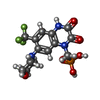
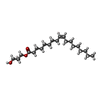
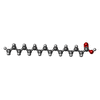


 解析
解析 試料調製
試料調製 電子顕微鏡法
電子顕微鏡法 FIELD EMISSION GUN
FIELD EMISSION GUN
 ムービー
ムービー コントローラー
コントローラー




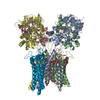




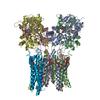
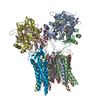
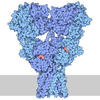
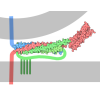

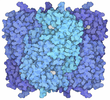
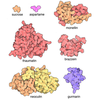

 Z (Sec.)
Z (Sec.) Y (Row.)
Y (Row.) X (Col.)
X (Col.)
